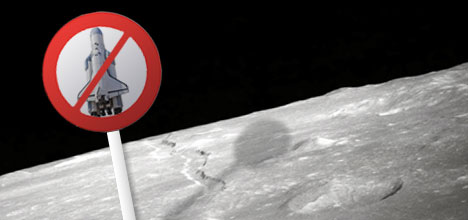Tauranga astronomer Stuart Murray says NASA's move to declare ‘no fly zones' on the moon is 'a bit precious”.
NASA, the organisation which pulled the pin on its ageing shuttle fleet without offering a replacement, and is now contemplating ending the life of the international space station – is planning on introducing lunar no fly zones by the end of September.
The zones are intended to preserve the Apollo landing sites and artefacts left on the moon during the manned landing programme 40 years ago.
NASA's no fly zones are prompted by the Google Lunar X prize, the $30 million competition for the first privately funded team to send a robot to the moon.
The robot has to be able to move 500 metres and send images from the moon. Precise landing near the Apollo sites would get them more money.
'Personally I think it's fair game for anybody to try and get pictures,” says Stuart.
'It is 40 year old stuff – that's my own personal opinion.
'I really can't see the reason for it (no fly zones), these things become a bit precious don't they.”
There are more than three dozen historical lunar sites where Apollo programme remains are located, which include the footprints of the first explorers on the moon and the rubbish they left behind.
NASA is proposing 2km no fly zones over the sites.
The Apollo 11 and 17 sites will be off limits, with ground-travel buffers of 75 metres and 225 metres from each respective lunar lander, states the July 20 guidelines of NASA, as published in Science.
According to Science, NASA is expected to come up with a set of 'recommendations” for spacecraft and astronauts visiting 'US Government property on the moon”.
The property was abandoned and the 1967 Outer Space Treaty makes it clear that the lunar surface has no owner, so the recommendations will not be legally binding.
The restriction list includes preventing future explorers from studying discarded food and abandoned astronaut faeces.
Scientific study of the discarded food will reveal the viability of bacteria on the moon and, if present, how they have mutated and survived after decades of exposure to solar radiation and hard vacuum.
A study of any metallic objects left on the moon would reveal how these materials have degraded after prolonged exposure to the lunar environment.
'I can't see any reason why they should not allow it,” says Stuart.
'It would be for the gain of everybody, including NASA and the people on this planet.”
NASA recently published pictures taken from its Lunar Reconnaissance Orbiter showing the Apollo 12, 14 and 17 landing sites.
Stuart says he's recorded the item and will put the pictures on DVD.
'I was intrigued by the news item, and in the fact they have recorded the photographs of both foot prints and tyre tracks,” says Stuart.
He's going to show them at the upcoming Tauranga Astronomical Society meeting, and he will keep a copy on hand for people like the man who accosted him last week – arguing that the Americans never landed on the moon.



1 comment
Just wondering
Posted on 10-09-2011 15:28 | By The author of this comment has been removed.
Having looked at the NASA pics, my conclusion is a bit like looking at ink blots - there is a theory out there that the desire to stop anyone getting too close to the designated sites is to protect the fact that the pics will just not add up to any kind of support of what they are supposed to be. In others words who knows and furthermore 'who cares' - I actually like America and its people but this kind of arrogance is laughable - if the Chinese sent a mission to the Moon then I'd like to see the Americans trying to dictate where they were allowed to land and what they were allowed to explore...........
Leave a Comment
You must be logged in to make a comment.